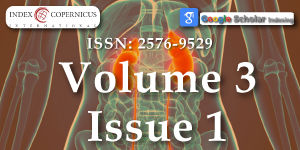A serious pulmonary infection secondary to disseminated Strongyloidiasis in a patient with Nephrotic syndrome
Main Article Content
Abstract
We report a case involving infection with Strongyloides stercoralis found in the sputum of a 66-year-old male patient who had a medical history of nephrotic syndrome and was treated with methylprednisolone and monthly intravenous cyclophosphamide therapy 3 months previously. This patient presented with stubborn pulmonary symptoms and signs, which was the mechanical destruction caused by larval migration. We found strongyloides in his sputum that provided diagnostic proof.
Article Details
Copyright (c) 2019 Ma M, et al.

This work is licensed under a Creative Commons Attribution 4.0 International License.
The Journal of Clinical Nephrology is committed in making it easier for people to share and build upon the work of others while maintaining consistency with the rules of copyright. In order to use the Open Access paradigm to the maximum extent in true terms as free of charge online access along with usage right, we grant usage rights through the use of specific Creative Commons license.
License: Copyright © 2017 - 2025 |  Open Access by Journal of Clinical Nephrology is licensed under a Creative Commons Attribution 4.0 International License. Based on a work at Heighten Science Publications Inc.
Open Access by Journal of Clinical Nephrology is licensed under a Creative Commons Attribution 4.0 International License. Based on a work at Heighten Science Publications Inc.
With this license, the authors are allowed that after publishing with the journal, they can share their research by posting a free draft copy of their article to any repository or website.
Compliance 'CC BY' license helps in:
| Permission to read and download | ✓ |
| Permission to display in a repository | ✓ |
| Permission to translate | ✓ |
| Commercial uses of manuscript | ✓ |
'CC' stands for Creative Commons license. 'BY' symbolizes that users have provided attribution to the creator that the published manuscripts can be used or shared. This license allows for redistribution, commercial and non-commercial, as long as it is passed along unchanged and in whole, with credit to the author.
Please take in notification that Creative Commons user licenses are non-revocable. We recommend authors to check if their funding body requires a specific license.
Olmos JM, Gracia S, Villoria F, Salesa R, González-Macías J. Disseminated strongyloidiasis in a patient with acquired immunodeficiency syndrome. Eur J Intern Med. 1996; 132: 977-978. Ref.: http://tinyurl.com/y4knykpk
Guo J, Sun Y, Man Y, Huang X, Qin Q, et al. Coinfection of Strongyloides stercoralis and Aspergillus found in bronchoalveolar lavage fluid from a patient with stubborn pulmonary symptoms. J Thorac Dis. 2015; 7: E43-46. Ref.: http://tinyurl.com/y5cejm63
World Health Organization. Soil-transmitted helminth infections [Internet]. Geneva: World Health Organization. 2017; Ref.: http://tinyurl.com/lttp57c
Tanton DD, Duming S, Chambers S. Pulmonary hyperinfection with Strongyloides stercoralis in an immunocompetent patient. Journal of General Internal Medicine. 2002; 17: 72-73. Ref.: http://tinyurl.com/y6xvcesm
Steinmann P, Zhou XN, Du ZW, Jiang JY, Wang LB, et al. Occurrence of Strongyloides stercoralis in Yunnan Province, China, and comparison of diagnostic methods. Plos Negl Trop Dis. 2007; 1: e75. Ref.: http://tinyurl.com/y3sxpl9r
Rogers JW Jr, Nelson B. Strongyloidiasis and malignant lymphoma. "Opportunistic infection" by a nematode. JAMA. 1966; 195: 685-687. Ref.: http://tinyurl.com/y4keso4j
Merzkani M, Uppal NN, Ross DW, Goyal PG, Malhotra P, et al. Strongyloides Stercolaris-Associated Tip Variant Focal Segmental Glomerulosclerosis. Kidney Int Rep. 2018; 3: 14-18. Ref.: http://tinyurl.com/yy34nxjv
Boulware DR, Stauffer WM, Hendel-Paterson BR, Rocha JL, Seet RC, et al. Maltreatment of Strongyloides infection: Case series and worldwide physicians-in-training survey. Am J Med. 2007; 120: 545.e1--8. Ref.: http://tinyurl.com/y6q5frv3
Namisato S, Motomura K, Haranaga S, Hirata T, Toyama M, et al. Pulmonary strongyloidiasis in a patient receiving prednisolone therapy. Intern Med. 2004; 43: 731-736. Ref.: http://tinyurl.com/y4fdv8oz

